- News
- Reviews
- Bikes
- Components
- Bar tape & grips
- Bottom brackets
- Brake & gear cables
- Brake & STI levers
- Brake pads & spares
- Brakes
- Cassettes & freewheels
- Chains
- Chainsets & chainrings
- Derailleurs - front
- Derailleurs - rear
- Forks
- Gear levers & shifters
- Groupsets
- Handlebars & extensions
- Headsets
- Hubs
- Inner tubes
- Pedals
- Quick releases & skewers
- Saddles
- Seatposts
- Stems
- Wheels
- Tyres
- Tubeless valves
- Accessories
- Accessories - misc
- Computer mounts
- Bags
- Bar ends
- Bike bags & cases
- Bottle cages
- Bottles
- Cameras
- Car racks
- Child seats
- Computers
- Glasses
- GPS units
- Helmets
- Lights - front
- Lights - rear
- Lights - sets
- Locks
- Mirrors
- Mudguards
- Racks
- Pumps & CO2 inflators
- Puncture kits
- Reflectives
- Smart watches
- Stands and racks
- Trailers
- Clothing
- Health, fitness and nutrition
- Tools and workshop
- Miscellaneous
- Buyers Guides
- Features
- Forum
- Recommends
- Podcast
review
£1,900.00
VERDICT:
Fast, stable and comfortable, and a few upgrades will make it even better
Weight:
8,310g
Contact:
At road.cc every product is thoroughly tested for as long as it takes to get a proper insight into how well it works. Our reviewers are experienced cyclists that we trust to be objective. While we strive to ensure that opinions expressed are backed up by facts, reviews are by their nature an informed opinion, not a definitive verdict. We don't intentionally try to break anything (except locks) but we do try to look for weak points in any design. The overall score is not just an average of the other scores: it reflects both a product's function and value – with value determined by how a product compares with items of similar spec, quality, and price.
What the road.cc scores meanGood scores are more common than bad, because fortunately good products are more common than bad.
- Exceptional
- Excellent
- Very Good
- Good
- Quite good
- Average
- Not so good
- Poor
- Bad
- Appalling
The Merida Ride 5000 is the definitive mile-muncher: fast and comfortable, built for UK roads and weather. But it needs better tyres and deserves better wheels.
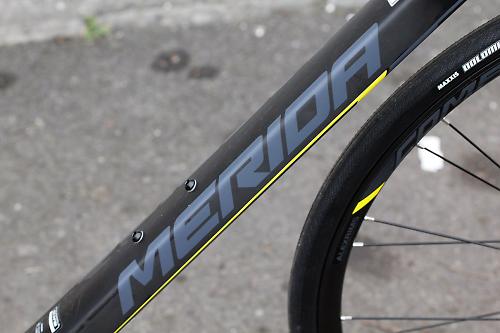
Dave covered the technical detail of the Ride 5000 in his Just In article so I won't dwell on the geometry detail. Suffice to say the answer to his ultimate question "On paper it certainly offers very good value for money, will it ride as well as it looks?" is a resounding "Yes". This bike is fast, comfortable and forms a great platform for future upgrades.
Buy the Merida Ride 5000
Find a Merida dealer
First impressions

On the forecourt of the town hall for a club run the Ride 5000 drew appreciative comments for its minimalist graphics and interesting combination of curved tubes and chunky boxes. It's a frame you'll grow to love – distance makes the heart grow fonder and all that. The first (and possibly only) upgrade I'd make purely for aesthetic reasons would be swapping the RS-500 chainset for an Ultegra four-arm – something easily done for maybe £50 all transacted on your favourite auction website. The only other non-Ultegra items are the 105 cassette and FSA chain, and I'm not sure many would notice the difference going upspec.
As Dave mentioned this is one tall bike. I ended up with the stem slammed (as low as possible under the spacers), but still a whopping three centimeters higher than my bikefit dictates. The higher bars were also wider than my usual at 420mm – narrow of shoulder persons should be looking for the shop to swap these out at purchase. The bar tape was nice and thick, and when paired with the slightly flattened tops made for a wide platform to rest hands on.

Staying at the sharp end, Merida's proved beyond doubt that through-axles on roadbikes Just Work. To remove the front wheel you flip the lever completely over to engage the notch in the axle body, then unwind six times using one finger on the lever. To reinstall, wind the axle in using the lever. When it bottoms out, simply wind back half a turn and flip closed. This quickly became intuitive, and no doubt contributes to the rock-solid steering and confident braking. No faff with lawyer-lips, or back-and-forth with two hands getting the skewer tension just right by tweaking the opposite nut. There's a standard quick release on the rear, but even under heavy braking it never shifted or allowed any rotor rub.
The shifter cables enter the top of the hefty downtube at a slight angle, and the front shifter outer was cut 10cm too long meaning it hit the knees when out of the saddle. Trimming this back gave an opportunity to try out the internal cable routing, and it's nicely done. The pink-coloured liner tube runs full length from the top entry point and out under the bottom bracket, making threading a new front shift cable the work of seconds.

The rear mech cable is a filth-defeating continuous run into the downtube, through the bottom bracket and inside the chainstay, emerging at the bottom of the seatstay in a neat arc.
Throughout the test period no rattling was heard from any cables. Both shift cables feature in-line barrel adjusters at the stem for mid-ride tweaking. Merida say the frame is fully Di2-ready including for a seat tube battery (there's a small rubber bung just below the front mech), for those wishing to really push the upgrade boat out. The front brake cable is routed through the fork, keeping things looking tidy and consistent with the frame.
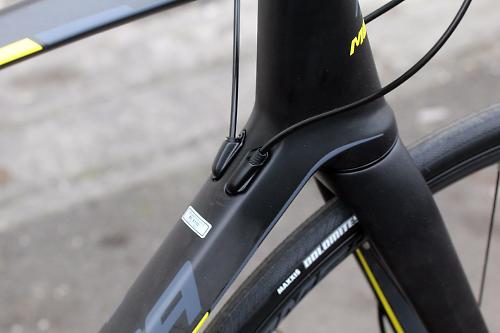
Whilst the FrankenGroup doesn't noticeably affect performance, the wheelset leaves a good deal to be desired weight-wise. With no rubber on, and including the 105 cogset (320g) plus rotors (100g a go) the pair weigh in at 2.86kg - so naked that's about 2.34kg worth of hoops. In a market where around £200-worth of disc-ready wheelset could save you nearly half a kilo, it seems a strange compromise on such a great frame. Definitely the first place to be putting any upgrade cash, to get yourself a sub-8kg sportive-eater.
First Ride
On the first genteel 20 miles to a pub the impression was not great – harsh, skittish and during an attempt to burn in the TRP HyRd brakes descending on a dry, smooth road, downright pants-fillingly-scary. Thankfully this was down to the spec'd Maxxis Dolomite 25mm tyres being totally unsuited for the sort of riding this bike is built for. It felt like it was on rails, but not in a good way.
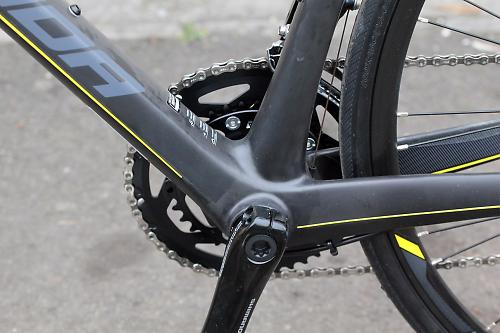
The Dolomite is a self-admitted 'lightweight competition' tyre, so what it's doing specced on an all-day bike with clearance for 30mm tyres is beyond me. Fitting my go-to 28mm Schwalbe One tubeless tyres changed things dramatically. Even with big rubber on not-so-wide rims there's 10mm of tyre-fork vertical clearance, and a larger 12mm tyre-mudguard stay clearance at the back. That's plenty of room for mudguards using the hidden mounts under the fork crown and seatstay bridge, and on the rear of the fork legs and seatstays. (The Merida guards weren't available to test at time of review).
When shod with the Dolomites comfort was on par with my steel Charge Juicer shod with 28mm tubeless, which was okay but disappointing given the shock-absorbing carbon/flax tech on offer. The seatpost is 27.2mm carbon, 5cm longer than on my Charge, so should be a lot comfier. But let's blame the tyres. On 28mm tubeless the bike immediately felt faster, far more comfortable and much more surefooted. Diving into swooping corners under heavy braking became something to be relished, not feared. On one ride I turned back uphill and re-rode an S-bend of Wiltshire lane, the hedge-free borders giving enough visibility to be sure you weren't setting yourself up to be a hood ornament at 40mph whilst diving through consecutive 90-degree bends. With the right rubber this bike is capable of descending feats well beyond the ability or nerve of most riders.

Longer and longer
So does such an upright stance mean a tradeoff in speed? Not likely. On the first fast, long hilly outing I knocked five minutes off a 40-mile personal best despite a 12mph headwind. The Ride 5000 got me down the 'Britain's 100 Greatest Cycling Climbs' Coombe Gibbet descent over 10mph faster than the five previous attempts on the same tyres, hitting 50mph before hauling on the anchors. Descending was scarily confidence-inspiring, the ability to change direction and brake into sharp turns urging you on. Laying the bike over in corners with good visibility was a joyous experience on fat, grippy tyres. This point-and-shoot confidence is largely down to the massive head tube and fork. There's not a bit of flex apparent under heavy braking or steering load, with matching bars and stem feeling tight.
So where does the long-distance speed come from? I'm a big believer in comfort equalling quick, and on the Ride 5000 it felt like there was a volume knob halfway down the bike - big hits on the front would come through muted at the back, even large hits that bumped you out of the saddle were damped. Gloveless hands felt the hits, felt in contact with the road but didn't get fatigued.
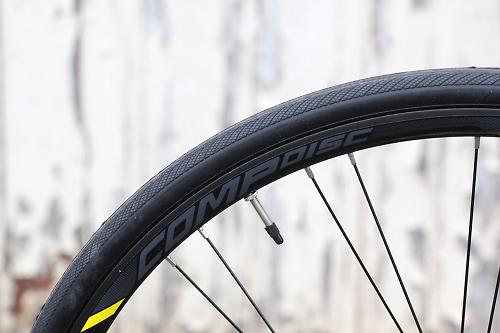
The Ride 5000 helped me bag a rather smug Strava third overall on the 10-mile, 1% descent of a local valley, at 23mph – a whole three miles per hour quicker than just two months ago. A few weeks later doing an out-and-back effort in the same valley in pouring rain, I knocked another 30 seconds off that.
Given zero change in diet/training I put this 100% down to the bike. It was very comfy in the drops, never feeling like I was 'climbing' up or down to change hand position. Riding over the poxy, patched chip seal the vibrations were damped out almost to the point of invisibility. It's like the back half of the bike is riding over a different road, possibly a lovely tarmac one in rural Belgium funded by your EU contributions. The Prologo Kappa2 saddle was on par with my trusty Charge Spoon, either sitting back or on the rivet for quarter of an hour at a stretch.

Sprinting for signs on the flat or stomping on the hills, there's no flex evident through the frame; every erg is rewarded, even with the price-point-meeting wheels.
With the sportive market firmly in mind the Ride 5000 begs to get out for the day. On a 100-mile outing through the New Forest I was able to sit on 19mph for the first three hours, comfortable over bumpy rural roads and tight as a drum zipping across the New Forest's iconic ponied plains whilst gripping the generous Ultegra hoods like faux aerobars. The height of the drops meant long stretches low-down didn't feel like penury, and after five hours the Kappa2 saddle wasn't causing any discomfort, a few out-of-the-saddle stretches keeping numbness at bay.
Minor niggles
The rear wheel was very pingy after 60 miles – It quietened down a good deal after being stress-relieved (pinch parallel pairs of spokes on the same side to overtension them, then release – gloves recommended), and once settled I had to tighten a spoke that was catching on the rear mech. A further 150 miles on the wheel was silent, all spokes having settled into place. Something to ask your bike shop to check before delivery or at the six-week free service, if there's one on offer.
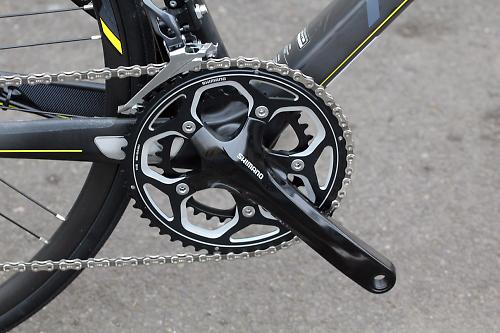
Some 500 miles into testing a rattle appeared that defied all logic. Pulling on cables, gripping tubes, cages, in or out of the saddle, pedalling or not, nothing made a difference. What it turned out to be was the thin washer between the rear hub non-drive-side bearing shield and the dropout locknut. A tiny amount of play had developed, hardly visible yet enough to make noise. There's no lock function between the bearing shield and the locknut, so it simply needs to be kept finger-tight. This locknut unwinding a fraction also affected the brake rotor alignment as it pushed the caliper outwards in relation to the hub. Not the best of setups, and more reason to consider a long-term wheel upgrade away from the heavy stock wheelset with their price-point-meeting Formula hubs. About the time the rattle appeared the Joytech freehub started emitting gritty noises and was replaced immediately, as you'd expect under warranty.
The highly-regarded TRP HyRd cable-actuated hydraulic-cylinder brakes needed some aligning and rotor truing out of the box, and despite a fair bit of fettling the front remained grabby. It wasn't noticeable at speed, but when going slowly the cutouts of the 'wavy' rotor made the brake pulse something chronic, to the point that on a slippery surface on the edge of grip, the uncalled-for modulation could result in locking up the wheel.
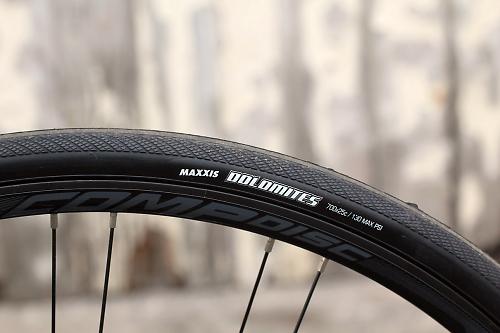
Obviously this isn't Merida's fault, so I asked TRP. They advised this rotor design is to assist with mud clearing, but come on: this is a road bike, not a 'crosser, and I've never felt the need to run wavy rotors on any of my mountain bikes.
Fitting some non-wavy rotors solved the problem immediately. The front brake was notably quieter, with better modulation and better low-speed performance. It would be great to see road bike manufacturers paying attention to this sort of thing when speccing disc brakes in future. Another thing to maybe get the LBS to check/swap, if you find the experience lacking.

Overall impressions
I can't help but think the Ride 5000 would be better off specced with the full 105 5800 group, paired with Shimano's RS685 hydro brakes. This might add maybe a hundred quid to the price, but would be worth it for the consistency of look, feel and braking improvement. Sure, you wouldn't get the cachet associated with having ULTEGRA emblazoned on your levers, but let's face it: anyone who either cares or knows their stuff will spot the budget RS-500 crankset long before they read the levers. Every review in the last year has questioned the wisdom of spending the extra for Ultegra over 11-speed 105, and the Ride 5000 spec is this argument writ large. If not for full hydro brakes, Merida should go for 105 and spec lighter wheels.
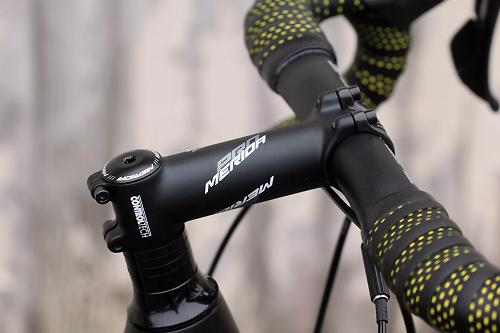
The 2016 incarnation of the Ride 5000 Disc has been announced for release in late October, and comes with the new ST-RS505 hydraulic 105-grade shifters connected to the slimline RS785 hydraulic disc callipers for £1950, retaining the Ultegra mechs. That's a nice package that. Plus the wheels are upgraded to Fulcrum's Racing Sport Disc, which at 1872g the pair are pretty much bang on the desired half-kilo lighter mentioned above.
If you can't wait for the 2016 model, for £1900 notes (less for clearouts) and on different tyres the 2015 Ride 5000 delivers comfort, speed and smiles. It's a solid platform to spring some birthday money on tyre, wheel or component upgrades (in that order) without feeling you're dollying up the porcine. After a month or two of club runs, personal efforts and centuries my overall impression of the Ride 5000 on decent tyres is very good. It's made me faster and happier with no extra effort on my part - and if you're into Strava-sniping, it should give you a leg up on the local Back Lane Warriors. I'd recommend it to a friend I had to ride with often, and you don't get much higher regard than that.

Verdict
Fast, stable and comfortable, and a few upgrades will make it even better
road.cc test report
Make and model: Merida Ride Disc 5000
Size tested: 57
About the bike
State the frame and fork material and method of construction. List the components used to build up the bike.
* Full carbon frame with flex stays, nano matrix, tapered head tube, internal cable routing and fitings for mudguards
* Shimano Ultegra groupset with RS500 chainset
* Tektro HyRd mechanically activated hydraulic disc brakes
* Full carbon fork with tapered steerer and internal cable routing
* find full spec on http://2014.merida-bikes.com/en_gb/bikes/leisure- commuting/disc-road-bike/2015/ride-disc-5000-3850.html
COLORS silk UD (dark grey/yellow)
FRAME SIZES 50cm52cm54cm56cm59cm
FRAME RIDE DISC CF2
FORK Race carbon disc 15
DERAILLEUR REAR Shimano Ultegra GS
SHIFTERS Shimano Ultegra
BRAKE LEVER attached
BRAKES Tektro HYRD disc 160 / Tektro HYRD disc 160 connect
CHAINWHEEL Shimano RS500 50-34
BBSET attached
CHAIN FSA F11S
HUBS Bearing Disc-15 Road Axle / Bearing Disc cassette
RIM Merida comp 22 disc pair
FREEWHEEL Shimano CS-5800-11 11-32
TIRES Maxxis Dolemites 25 fold
HANDLEBAR STEM MERIDA pro CF OS -5
HANDLEBAR FSA Gossamer compact OS
HEADSET Big Conoid S-bearing neck pro
SEAT POST MERIDA carbon H SB15 27.2
SADDLE Prologo Kappa 2
Tell us what the bike is for, and who it's aimed at. What do the manufacturers say about it? How does that compare to your own feelings about the bike?
Part of Merida's 'Leisure/Commuting' range, I can't find any official marketing blurb on the Ride 5000 so let's just say it's for people who want to go a long way, in comfort. Disc brakes and mudguard mounts let you do so in poor weather, so it's squarely aimed at the UK Sportive / fast commuter market, and I'd agree that's who it best suits.
Frame and fork
Overall rating for frame and fork
9/10
Tell us about the build quality and finish of the frame and fork?
Can't fault it. stiff as a broom where needed, nicely compliant where needed. It looks the business too, in the semi-raw carbon-and-yellow-paint.
Tell us about the materials used in the frame and fork?
Carbon, and flax.
Tell us about the geometry of the frame and fork?
Fairly relaxed. You can sit up off the bars at the end of a long day without being instantly flicked into a hedge, and it's predictable at speed.
How was the bike in terms of height and reach? How did it compare to other bikes of the same stated size?
It's tall, begorrah. If you are used to stem-chewing setups, it will feel like a Chopper.
Riding the bike
Was the bike comfortable to ride? Tell us how you felt about the ride quality.
Yes, super-comfy. Can't fault the ride, on the right rubber.
Did the bike feel stiff in the right places? Did any part of the bike feel too stiff or too flexible?
Spot on - stiff as anything around the headset, BB and rear axle, nicely forgiving around the seatpost.
How did the bike transfer power? Did it feel efficient?
Never felt like anything was being wasted.
Was there any toe-clip overlap with the front wheel? If so, was it a problem?
Not noticeably, and I have Size 11 flippers.
How would you describe the steering? Was it lively, neutral or unresponsive? Neutral and predictable. Never caught me out.
Tell us some more about the handling. How did the bike feel overall? Did it do particular things well or badly?
Confidence-inspiring. Point-and-shoot.
Which components had the most effect (good or bad) on the bike's comfort? would you recommend any changes?
Change of tyres gave it a totally different feel. Get rid of the 25mm, go fat.
Which components had the most effect (good or bad) on the bike's stiffness? would you recommend any changes?
Never felt the stem to be wanting, even though looking down silhouetted by that monster head tube it looks like a pencil.
Which components had the most effect (good or bad) on the bike's efficiency? would you recommend any changes?
The crankset didn't feel flexy, and with comfort = speed, those tyres '' they've got to go.
Rate the bike for efficiency of power transfer:
9/10
Felt perfectly efficient, grinding out of the saddle or flat out on the flat.
Rate the bike for acceleration:
7/10
Nippy, but those heavy wheels will have held it back from its potential.
Rate the bike for sprinting:
8/10
Being so solid, honking it on grippy tyres was a lot of fun.
Rate the bike for high speed stability:
10/10
Wow. Just...wow. So stable, it should carry a health warning.
Rate the bike for cruising speed stability:
10/10
Pootling along it felt like you could balance a pint on the top tube, were it a tad flatter.
Rate the bike for low speed stability:
8/10
Fine. No problems.
Rate the bike for flat cornering:
8/10
With the right tyres, no problem.
Rate the bike for cornering on descents:
10/10
I lived for this - it was so much fun to drop into corners. Absolutely solid.
Rate the bike for climbing:
7/10
Being so stiff it was efficient, but being so upright could mean needing to lean further forward on the really steep stuff.
The drivetrain
Rate the drivetrain for performance:
7/10
It's a mish-mash, and not the quietest.
Rate the drivetrain for durability:
7/10
The Joytech freehub should be put In The Sea.
Rate the drivetrain for weight:
7/10
Compromises here. Not 'bad', but not 'very good' either.
Rate the drivetrain for value:
7/10
It's OK, but should have stuck with full 105.
Tell us some more about the drivetrain. Anything you particularly did or didn't like? Any components which didn't work well together?
That non-Ultegra crankset isn't the prettiest.
Wheels and tyres
Rate the wheels and tyres for performance:
5/10
Disappointing, on such a fab frame/fork.
Rate the wheels and tyres for durability:
5/10
Not great. Pingy spokes and a freehub dying after 500 miles are not premium experiences.
Rate the wheels and tyres for weight:
3/10
They're heavy. Way too heavy to do the frame justice.
Rate the wheels and tyres for comfort:
4/10
Out of the box, the tyres are too mean and un-grippy. Swap them at birth.
Rate the wheels and tyres for value:
4/10
The wheel/tyre package drags down the whole bike.
Tell us some more about the wheels and tyres.Did they work well in the conditions you encountered? Would you change the wheels or tyres? If so, what for?
They weren't good. Yes, change them - tyres immediately for 28mm Conti's or Schwalbes, and change the wheels as soon as you can afford to for anything sub-2000g that gets good reviews.
Controls
Rate the controls for performance:
10/10
It's Ultegra. Can't fault it.
Rate the controls for durability:
10/10
Zero issues.
Rate the controls for weight:
10/10
It's Ultegra. Can't fault it.
Rate the controls for comfort:
10/10
It's Ultegra. Can't fault it.
Rate the controls for value:
8/10
105 would have done the same job.
Tell us some more about the controls. Any particularly good or bad components? How would the controls work for larger or smaller riders?
Can't fault Ultegra, paired with Ultegra mechs.
Anything else you want to say about the componentry? Comment on any other components (good or bad)
The TRP HyRD's were OK, but the front was very grabby - to the point of traction-losing at low speeds on slippery stuff. A solid rotor made a big difference, and Merida really shouldn't have spec'd a CX rotor for a roadbike.
Your summary
Did you enjoy riding the bike? Yes indeed.
Would you consider buying the bike? This is tough. Not at RRP, as I now know I'd be wanting to swap the tyres and wheels on Day One.
Would you recommend the bike to a friend? Yes, but with the caveats re wheels and tyres.
Rate the bike overall for performance:
8/10
Rate the bike overall for value:
7/10
Use this box to explain your score
This is tough. With decent fat tyres, it's an 8. With even slightly better wheels it'd be an 8.5, possibly 9. But the spec tyres and brake rotor choice, coupled with the sea-anchor pingy wheelset drag the out-of-box experience down to a 7. On a slightly sub-£2k bike you shouldn't have to worry about such things, and smarter speccing would have delivered this. That said, I smashed loads of PB's and leapt up the Strava ladders on many local roads, so don't get me wrong - it's a very good bike. Conflicted.
About the tester
Age: 42 Height: 183cm Weight: 72KG
I usually ride: Charge Juicer My best bike is:
I've been riding for: Over 20 years I ride: A few times a week I would class myself as: Expert
I regularly do the following types of riding: club rides, general fitness riding, fixed/singlespeed, mtb, MTB, singlespeed and Dutch bike pootling
Living in the Highlands, Mike is constantly finding innovative and usually cold/wet ways to accelerate the degradation of cycling kit. At his happiest in a warm workshop holding an anodised tool of high repute, Mike's been taking bikes apart and (mostly) putting them back together for forty years. With a day job in global IT (he's not completely sure what that means either) and having run a boutique cycle service business on the side for a decade, bikes are his escape into the practical and life-changing for his customers.
Latest Comments
- David9694 2 sec ago
Woman taken to hospital after flipping car onto roof in Trowbridge...
- A V Lowe 42 min 31 sec ago
Its blindingly obvious from the image that the DKE of the buses include the mirrors which extend to nearly reach the edge of the tarmac pavement on...
- Sredlums 1 hour 15 min ago
It's sad when being very good at your job - any job - isn't enough to earn a decent living. It shouldn't be that way....
- eeney 1 hour 27 min ago
Bont double wide wearer here. Even Lake, for me, are too narrow in the toebox and midfoot, but Lake work for a lot of people....
- ktache 1 hour 43 min ago
I seem to recall saint Chris being more on recent BBC road cycling coverage rather than less.
- Rendel Harris 2 hours 3 min ago
So either it has to have the characteristics of a pogo stick or, more likely, that's a typo for "bunch sprint", which is equally nonsensical...
- chrisonabike 2 hours 55 min ago
I never heard of anyone having their leg sliced off / unexpectedly wiping out using a spoon brake, but discs...
- chrisonabike 2 hours 57 min ago
Meanwhile, in the Netherlands... (cycling to hospital, s''Hertogenbosch, Utrecht. Cycling to hospital and cycle parking, Assen)....
- Rendel Harris 3 hours 23 min ago
Sorry to say but your current trainer isn't going to be much use for online training in the way you describe, your virtual trainer will rely on not...


































Add new comment
18 comments
Thanks for all the advice. The SKS 'guards I bought have plastic ends / mounts, so they can't be bent. Looks like I'll be trying your homemade mount idea, iwood. How did you connect the middle section of the 'guards when there are no calliper brakes mounts to connect them to?
Oh yeah, the front stay design has changed (used to be all metal but 'snapped' into plastic end, which could be removed if being fitted to non-standard mounts), but the rear stays should still be all metal, and just order a spare set of all metal stays (sks almost all bits as aftermarket spares), and that'll be the front sorted too.
Hi Jackseph.....apologies for calling you Joseph, mind was elsewhere at the time. For the rear I just drilled a hole at the same position for the corresponding screw hole on what was the rear brake bridge, then used a nylon spacer in between 'brake bridge' and mudguard to get correct spacing. For the front I did the same, prior to fitting the stainless steel bracket that I fitted my dynamo front light to. This of course originally meant removing the front mudguard mounting bracket.
When the dynamo light bracket was fitted I had to refit this bracket.
Hope this helps.
Thanks for the advice, but on a (fairly) expensive bike I want to have fixed, non chopped mudguards. Come on Merida. Where are these guards?
If you're going to fix them (i.e. leave permanently), half an hour with a Dremel/hacksaw is all it will take to modify something like an SKS Blumel to fit the front. The rear should fit fine, it's just a 90º bend as the mounts are on the rear of the stays.
Or, wait for Merida to come up with the factory fits
Why? SKS guards come with stays that are too long for pretty much any bike, the point being that they are meant to be manipulated/cut to fit your bike.
Merida are quite pants at doing accessories to fit their bikes, but then Giants Defy/Rapid guards don't fit their XXL model correctly, and neither does Giant do guards to git their TCR Espoir bike, despite it coming with guard eyelets (as it happens the Defy guards fit, with the help of some cable ties and a minor alteration - are you spotting a theme here!).
In fact, point me to a manufacturer that does do decent guards to go with their bike - not saying there aren't any but they will be the exception.
I bought a 7000 Disc a month ago, here in Australia. 2015 model, full Ultegra inc hydro discs, $4000 reduced to $2475. It's a very nice bike to ride once I put 28mm Pro Endurance tyres on. It's a bit heavy at 8.6kgs, but I bought it as a dedicated rain bike as I have a Ti Merlin for the dry.
Here lies my problem though. The 7000 disc (and I presume the 5000 too) has mudguard mounts on the back of the seat stays and fork, making all known mudguards incompatible. I bought SKS Chromoplastics, but they can't fit. I have called Merida's distributor here in Oz twice and their advice was 1- buy mudguards with metal arms and bend the fittings with pliers and 2- "leave it with me and I'll call you back" two weeks ago.
I've put a msg on the Road.cc forum, with no comments, so I ask again.... HELP!
Yeah, they didn't have any here in the UK either. I've asked a few times, they are 'on the way'.
Having successfully done a fair bit of mudguard bending in my time ( http://gateauvelo.blogspot.co.uk/2013/03/sks-race-blade-long-and-650c-wh... ) it's do-able - I put a set of SKS Raceblade Longs onto my wife's disc-equipped bike with mounts in the same place - bit of choppy choppy and job done.
If/when I hear from Merida UK about guards I'll update here.
1. Merida are not the only brand using this style of mount.
2. I am yet to find a disc road bike that doesn't need at least a bit of mudguard stay manipulation (I worked in a shop for a while and fitted many guards).
3. Bend the end of the sks stays by 90 deg, and get slightly longer bolts that those supplied with the bike. You'll find you need to move the stays up/down forward/ back to align with the fixing positions on the guards, but no big deal (do not do the last bit with the fitted to the bike as you might strip the bolt out the frame). Not a big deal, particularly as the decent SkS guards take 45 mins plus to fit properly anyway.
Hi Joseph, I too have the 7000 model, but I imported mine from Germany as they don't do this model in the UK. Got to say it is a fantastic bike in every way, managed the PBP2015 on it and all the qualifying rides this year. I too had an issue with mudguards, but being a practical kind of bloke I made brackets for both the front and rear to enable me to fit SKS Chromoplastic mudguards. I used some 1.5mm Stainless steel sheet and cut strips 12mm x 45mm to form brackets that I could mount onto the frame using slightly longer AK stainless steel screws. I then used more SS bolts and nuts to then attach the mudguard stays to the brackets. Please see photos, of brackets (covered in black heat shrink) pre bike fitting and then fitted to bike and the bike then with mudguards fitted. Also had to use some more stainless steel in making a bracket to fit my dynamo front light. Unfortunately bike manufacturers in general seemed to have overlooked the need to keep the through bolt holes where calipers used to be mounted, in order to fit bike lights. This time I used some 3mm thick stainless steel. Hope this helps.
2015-08-12 00.05.20.jpg
I don't think he liked the tyres …………...
I'm glad my view of this bike has been backed up completely.
I got the ride disc 3000 (same frame, but prefered blue over yellow), stuck ultegra groupset with shimano hydraulics on the bike, with a set of am classic Argent Disc wheels, and the bike is amazing - much faster than my old Merida Reacto aero bike that it replaced, which I think is entirely down to how this bike deals with the bumps in the road.
It's not the lightest bike, but I think it's a fine demonstration of why people shouldn't get quite so hung up on overall weight, and instead look at where the weight is!
I really don't think it's fair giving this bike a 7, despite your reservations, given that despite the flaws you mentioned, you still said it was great!
Hi Joules1975
It's tricky, this review score thing - which is why unlike 'other sites' we have to back up our conclusions so readers can balance their own priorities. It would be unfair on purchasers to read what could be an 8 or 9/10 review, only to realise they have to spunk another 20-30% to get decent wheels, better-performing brakes and tyres. Basically, awesome frame/fork/finishing kit, above-average brakes out of the box and average-to-poor wheels, as Merida themselves have clearly recognised looking at the 2016 spec. On the Road.CC scoring scale that's not 'very good' let alone 'exceptional'. Now fixing those issues (tyres aside) and only adding £50 to the bill? that's exceptional.
Looking at the 2016 revision, I would expect to give that 8 or 9/10, based on my experience with the 2015. Hopefully they'll let me compare
Was it difficult routing the Hyd hose through the frame?
Did you need special bungs? If so where did you get them?
Thanks
Easy, and this is a little tip for any internal routing when changing the outer.
Before pulling the existing outer out, run a gear cable through it. Then pull the outer through from the opposite end making sure that the gear inner stays put. You can then tread the new outer (or hydraulic hose) over the gear inner and back through the frame using the gear inner as a guide.
[/quote]
Easy, and this is a little tip for any internal routing when changing the outer.
Before pulling the existing outer out, run a gear cable through it. Then pull the outer through from the opposite end making sure that the gear inner stays put. You can then tread the new outer (or hydraulic hose) over the gear inner and back through the frame using the gear inner as a guide.[/quote]
Thanks for that - its the sort of advise that could save me pulling my hair out. What about the bungs? Did you need new ones or did you need to widen the ones already there?
Easy, and this is a little tip for any internal routing when changing the outer.
Before pulling the existing outer out, run a gear cable through it. Then pull the outer through from the opposite end making sure that the gear inner stays put. You can then tread the new outer (or hydraulic hose) over the gear inner and back through the frame using the gear inner as a guide.[/quote]
Thanks for that - its the sort of advise that could save me pulling my hair out. What about the bungs? Did you need new ones or did you need to widen the ones already there?[/quote]
Hydro hoses are same diameter as standard brake outer, so no issues there either.
Nice bike, great review. I hate wavy rotors too and found these from Discobrakes. They're about 7 quid each and the quality is every bit as good as Avid or Shimano.
disco_brake_rotor_small.png